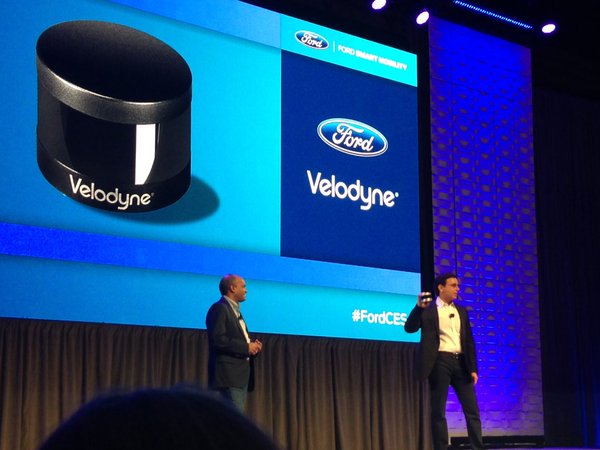Image: The Verge
At the 2016 Consumer Electronics Show in Las Vegas, Ford announced a key part of its autonomous vehicle strategy for 2016: Velodyne’s new LiDAR sensor, the Solid-State Hybrid Ultra PUCK Auto.
The Solid-State Hybrid Ultra PUCK Auto is Velodyne’s newest LiDAR sensor and the third generation of its autonomous vehicle sensor platform. Where the previous iteration of the PUCK sensor provides real-time 3D imaging out to a range of 100m, the Solid-State Hybrid Ultra PUCK Auto scans out to a range of 200m—a distance more appropriate to the needs of an autonomous vehicle.

Last year, SPAR spoke to Wolfgang Juchmann, at that time the director of sales and marketing at Velodyne, who explained the reasoning behind a 200m range. “A car’s computer will need to see farther out than current sensors allow in order to be effective at sensing objects and avoiding a collision,” Juchmann said. “If you go on a German highway and you drive 100 mph, you need to look much farther than 100 meters to make a decision and still be able to stop in 3 seconds.”
In Ford’s official statement the company praises the design of the sensor, which is small and light enough to be placed below a car’s side-view mirror. With that optimal placement, Ford is able to reduce the number of LiDAR sensors on their research vehicles from four to two, and greatly reduce the cost of the LiDAR system required for a fully autonomous vehicle.
”Adding the latest generation of computers and sensors, including the smaller and more affordable Solid-State Hybrid Ultra PUCK Auto sensors helps bring Ford ever closer to having a fully autonomous vehicle ready for production,” said Jim McBride, Ford technical leader for autonomous vehicles.
What The New PUCK Means for You
Though Velodyne has previously indicated that this particular sensor will only be available to auto makers, its release is good news for all of Velodyne’s customers.
- The research and development performed by Velodyne for this automotive sensor will enable them to improve sensors for other markets. When he spoke with SPAR last year, Juchmann said that the technology enabling the automotive sensor to scan at a 200m range would carry over easily to a sensor for the UAV mapping market.
- The announcement of a sensor for auto makers–companies that require a very high number of units–suggests that Velodyne is close to instituting their recently announced mass-manufacturing process. For Velodyne, this will reduce the cost of making each sensor. For consumers and professional buyers, this means there may be more affordable Velodyne sensors in the future.
- A PUCK designed specifically for the automotive market indicates that Velodyne is making good on their plan (as described by Juchmann) to add to their generalist products with sensors developed for the special needs of individual markets.
- Lastly, the “solid-state hybrid” designation of the sensor shows that Velodyne is already manufacturing solid-state LiDAR technology. This is good news, as solid-state technology promises to bring even smaller and less expensive LiDAR solutions down the road.
For more in-depth information about the benefits of the Solid-State Hybrid Ultra PUCK Auto, see SPAR’s conversation with Juchmann about the sensor last year when it was still in development.












